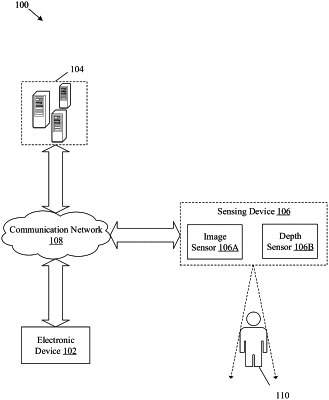| CPC G06T 19/20 (2013.01) [G06T 7/70 (2017.01); G06V 40/161 (2022.01); G06V 40/168 (2022.01); G06T 2210/16 (2013.01); G06T 2219/2004 (2013.01); G06T 2219/2021 (2013.01)] | 18 Claims |

|
1. An electronic device, comprising:
circuitry configured to:
acquire a set of depth scans of a person wearing clothes;
generate an initial body model of the person based on a first shape-fitting of a human body prior with at least a first depth scan of the acquired set of depth scans;
obtain a posed-body model based on a pose-fitting of the generated initial body model with at least one depth scan of the acquired set of depth scans;
determine, in each of the acquired set of depth scans, clothed scan points and unclothed scan points;
generate a final body model of the person based on a second shape-fitting of vertices which belong to the posed-body model and correspond to an under-cloth skin portion of a body of the person,
wherein the second shape-fitting is based on the determined clothed scan points and the determined unclothed scan points;
generate an initial texture map based on a mapping of skin pixels in one or more color images of the person to a coordinate map, wherein the generated initial texture map comprises:
one or more first regions which exclude a first texture of the under-cloth skin portion of the body in the one or more color images, and
a second region which is filled with a second texture of an unclothed skin portion of the body in the one or more color images:
apply a lighting correction to the generated initial texture map based on spherical harmonics;
fill the one or more first regions of the generated initial texture map with a color-tuned skin texture, based on the application of the lighting correction;
generate a skin texture map based on a map blending of the filled one or more first regions and the second region; and
texture the generated final body model based on the generated skin texture map for the body of the person.
|